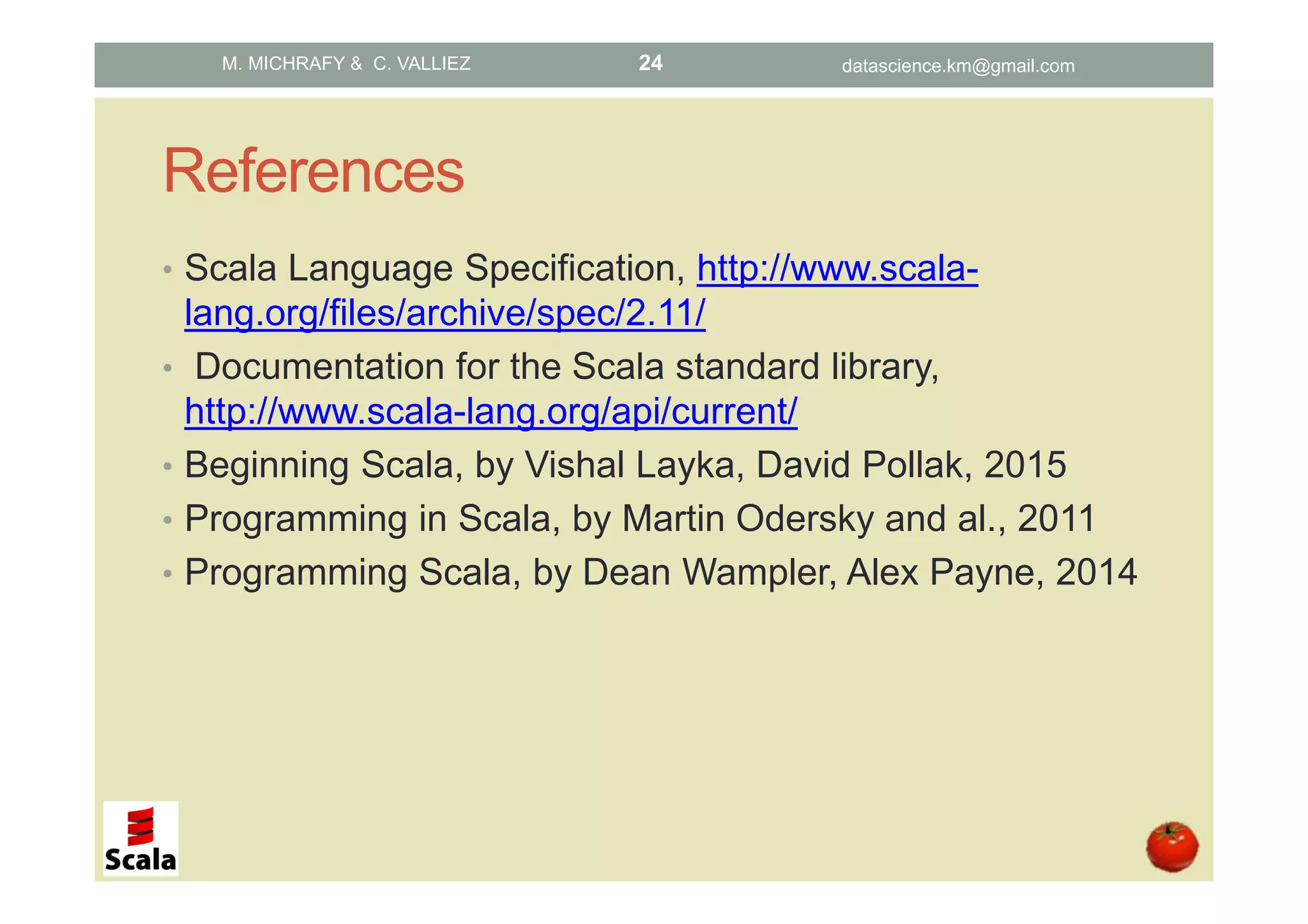This document discusses the implementation and concepts of pattern matching in Scala, structured around an educational seminar. It covers various topics including basic pattern matching, guards, recursive functions, and specific pattern matching for types, tuples, options, and collections. Additionally, it includes practical examples and code snippets to illustrate these concepts.
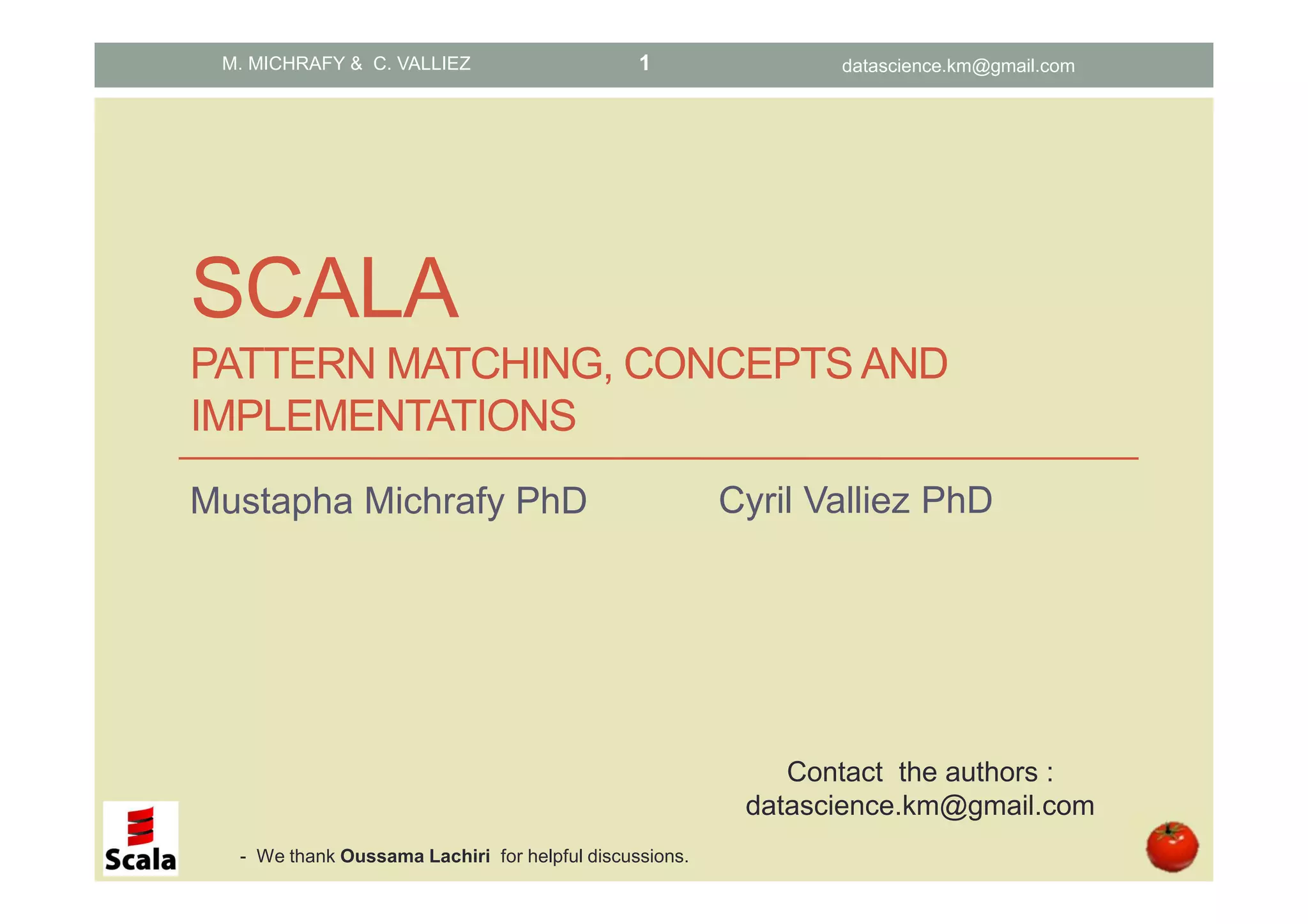
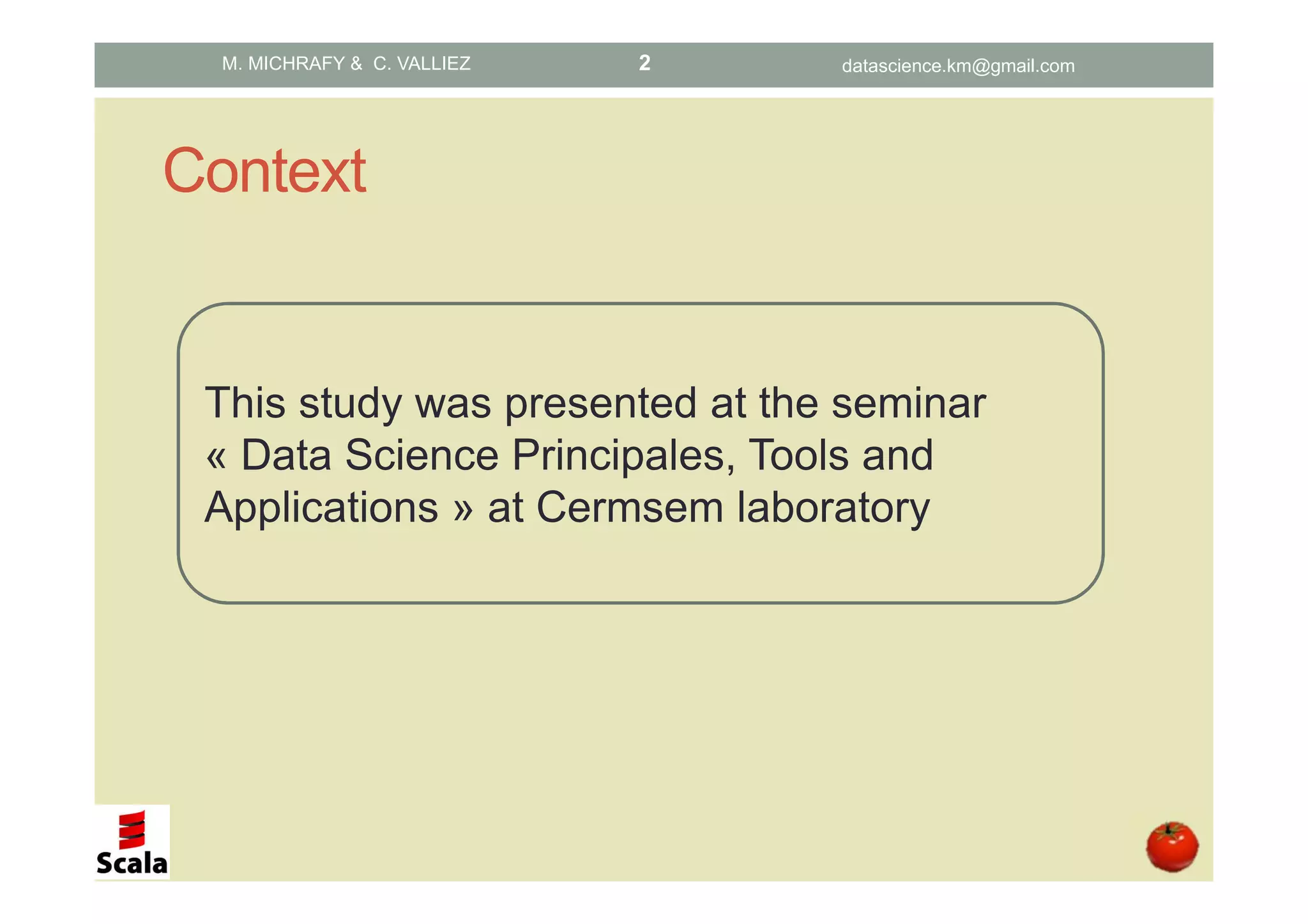

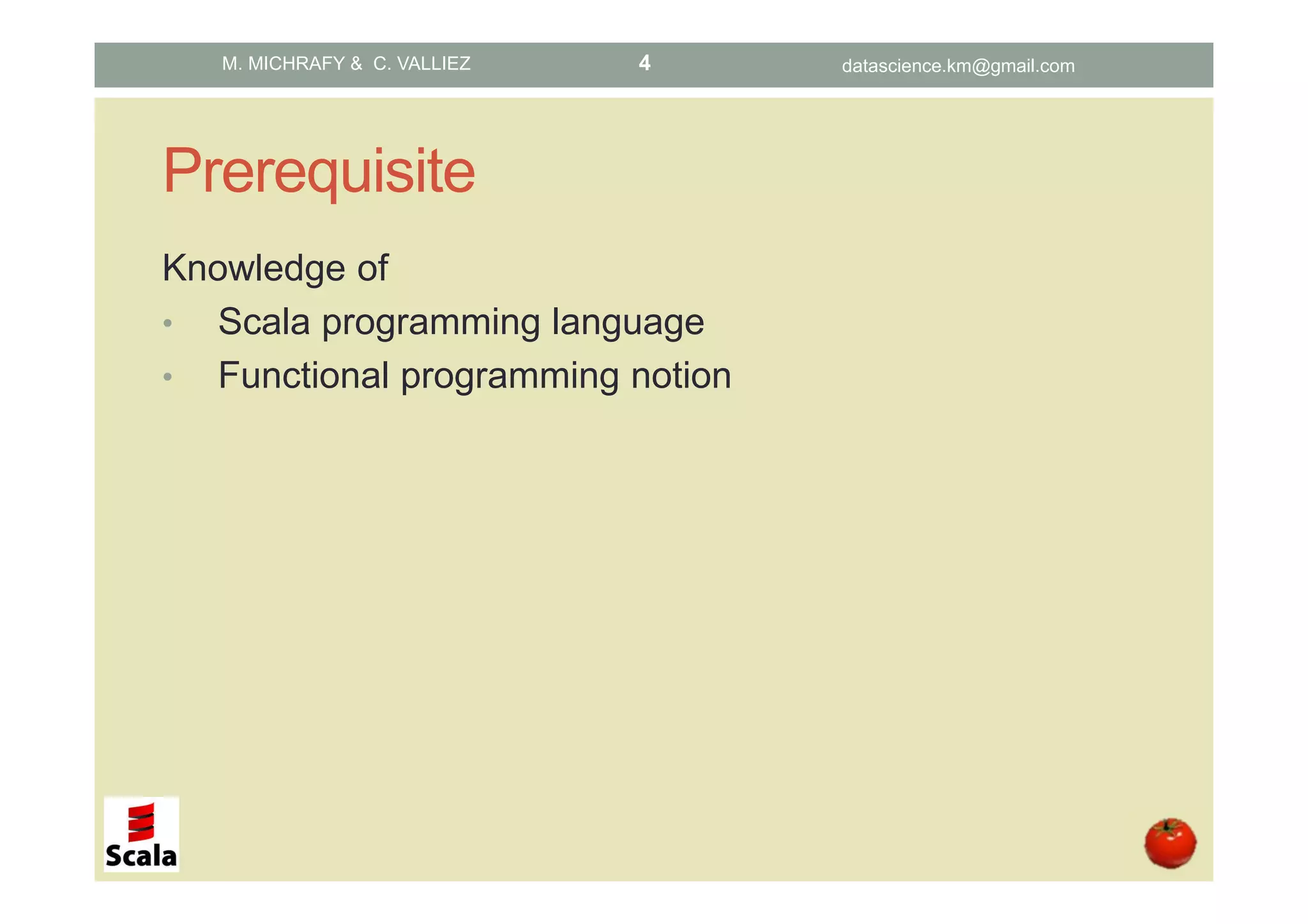
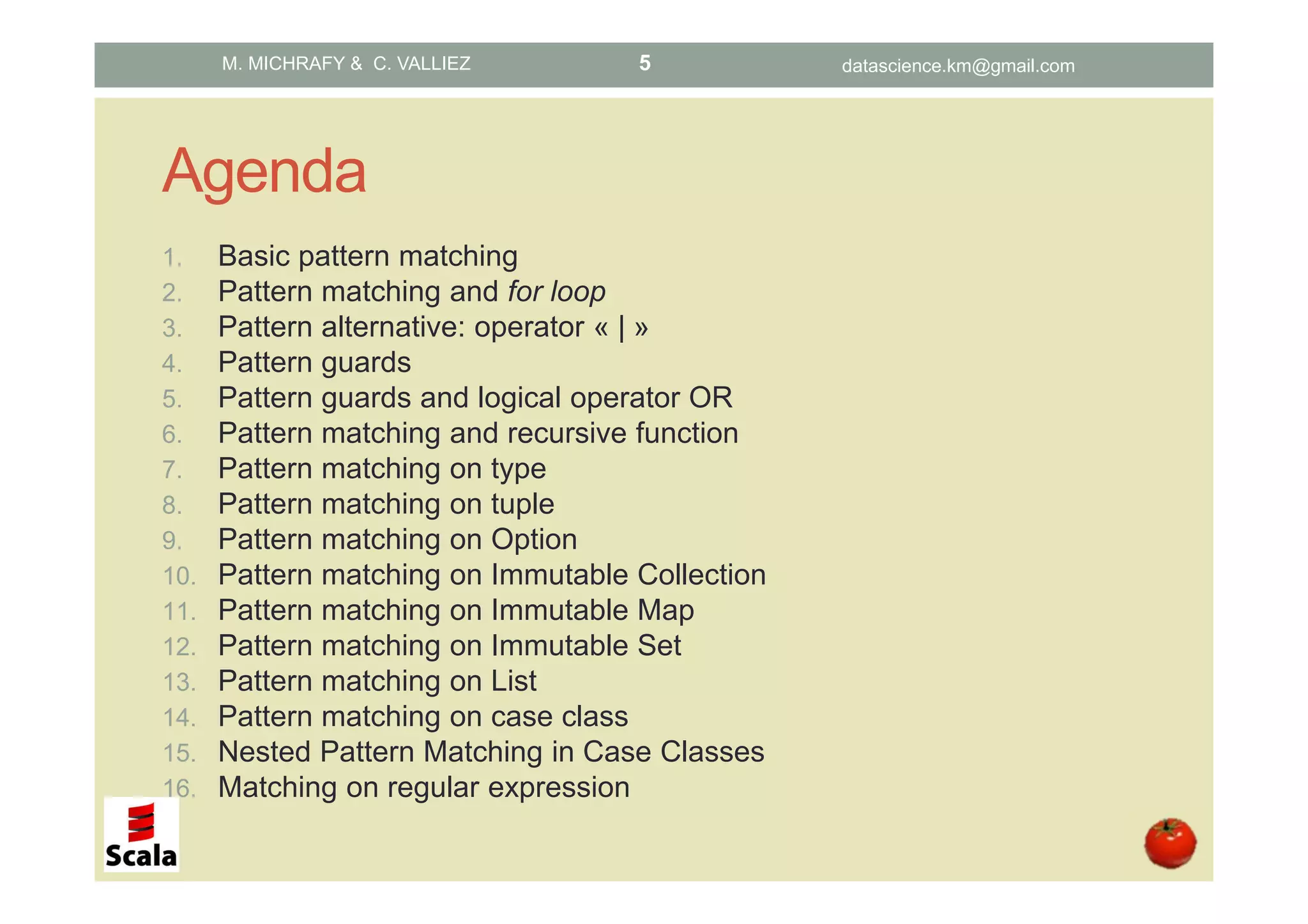
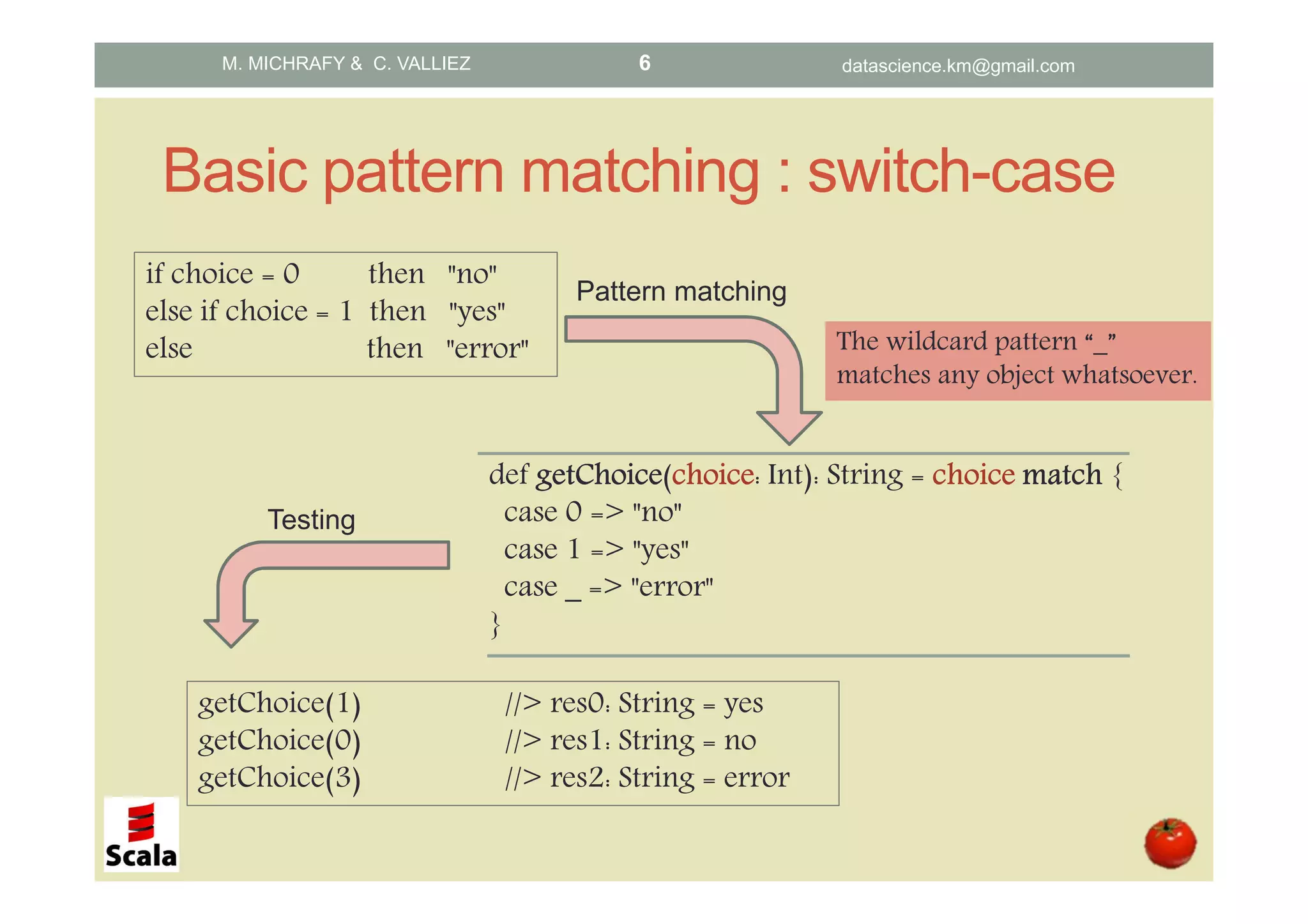
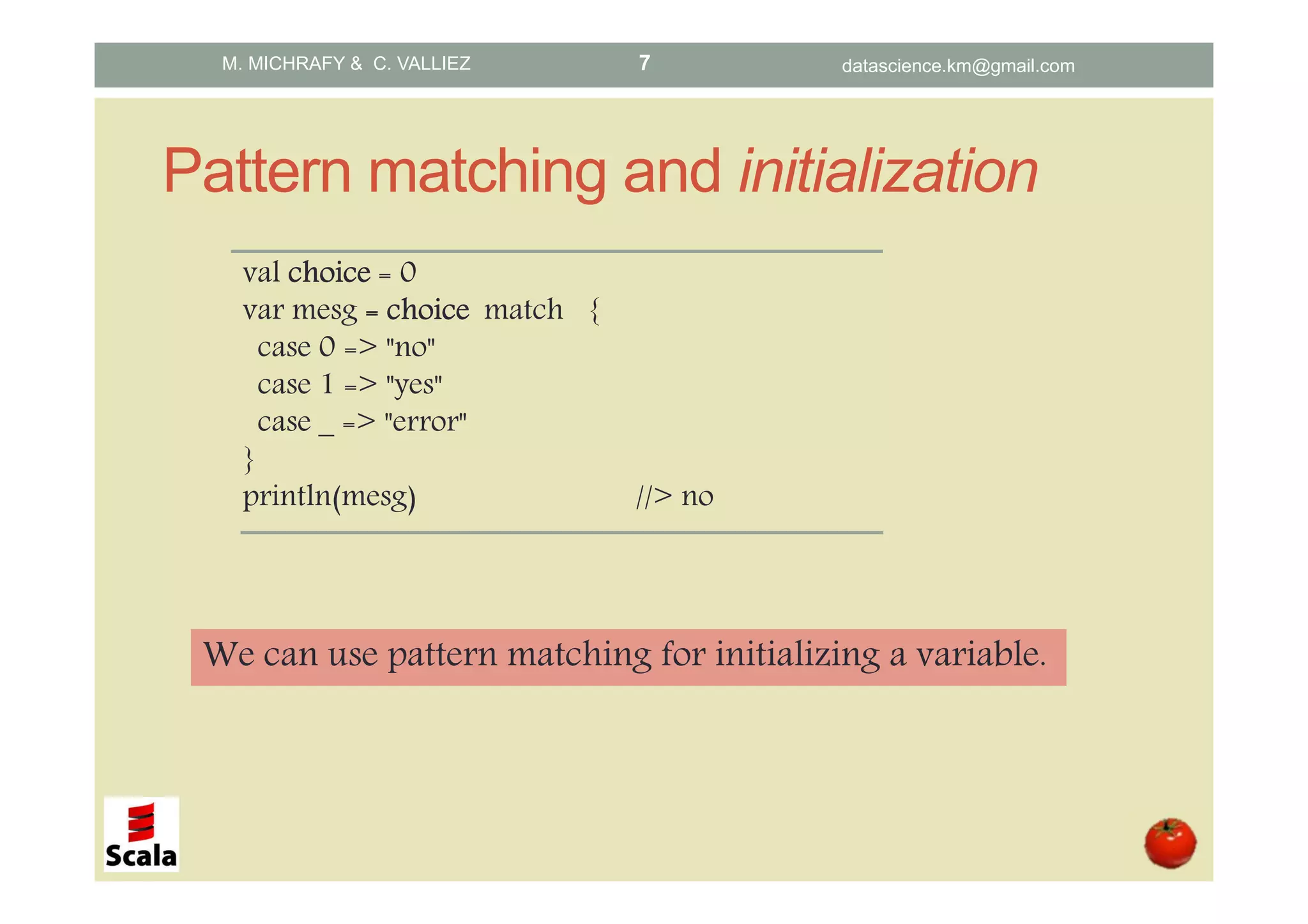
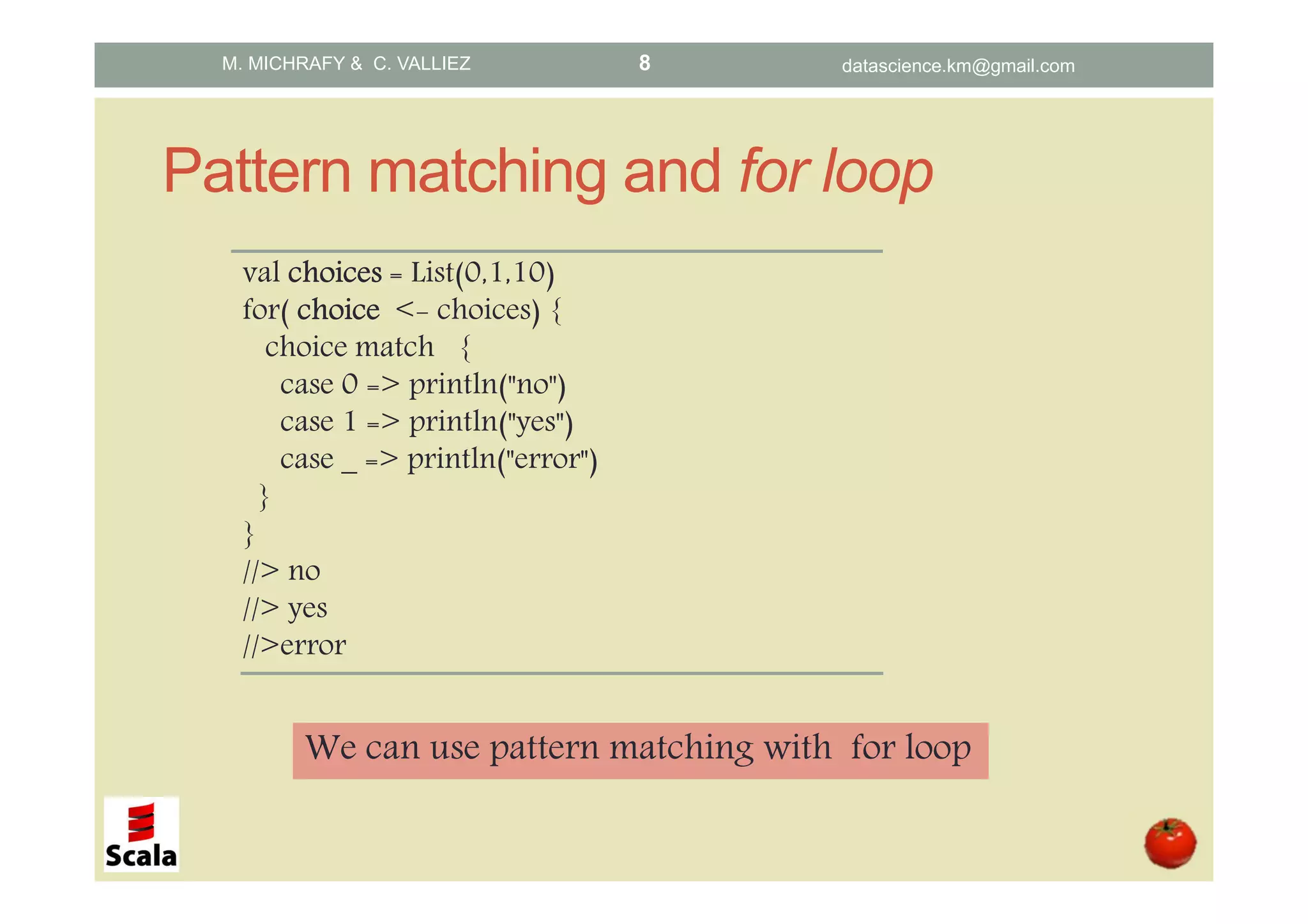
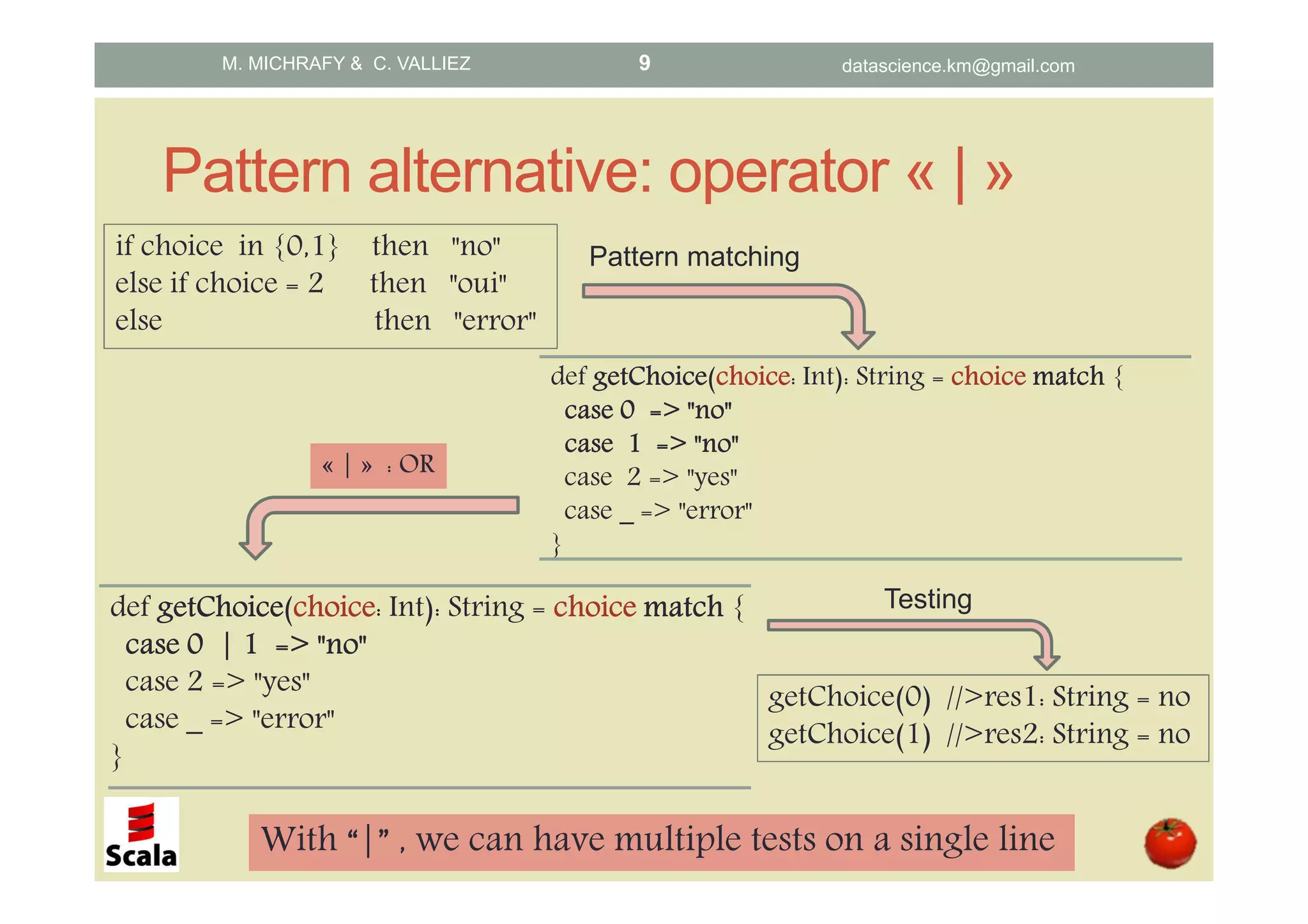
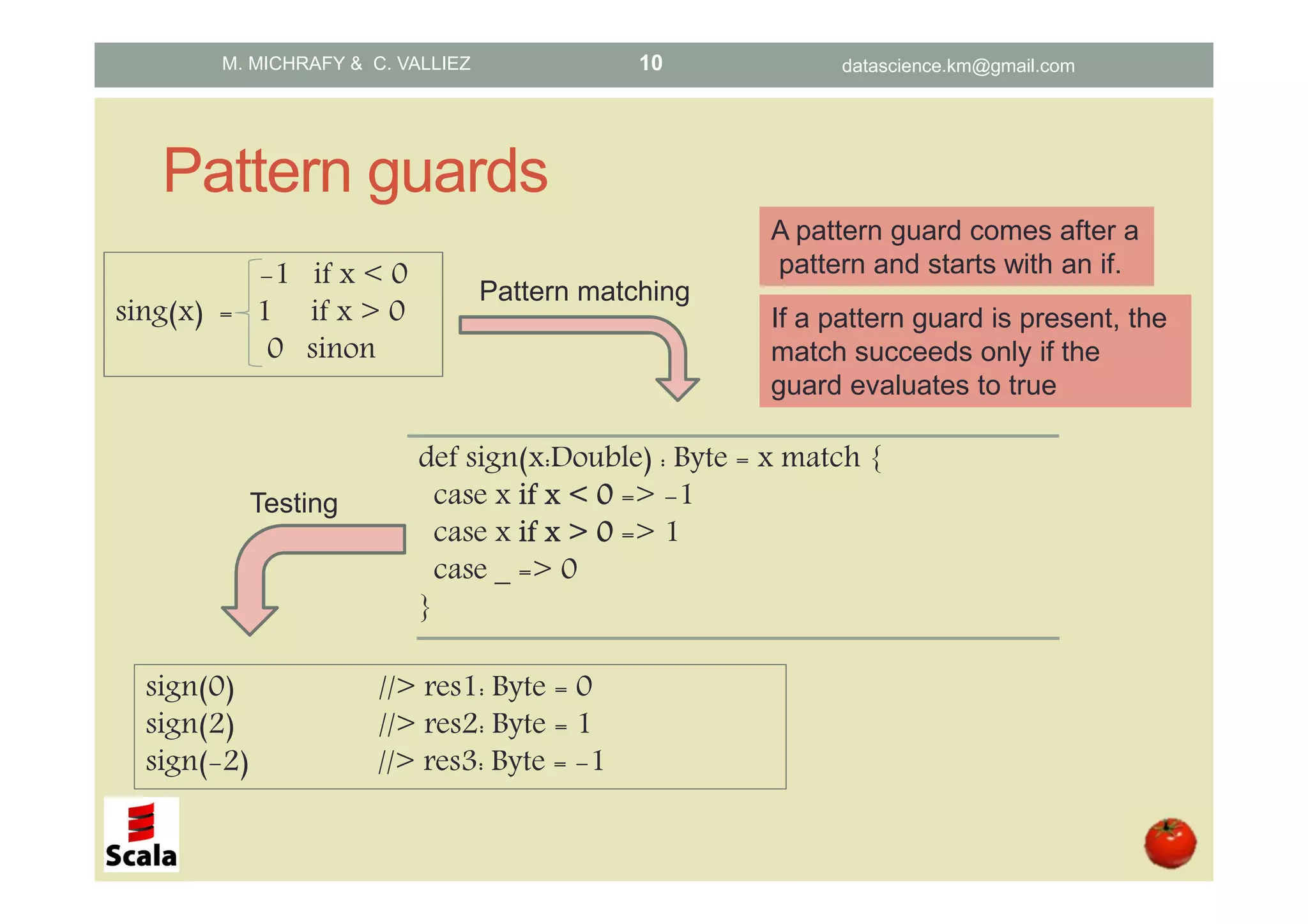
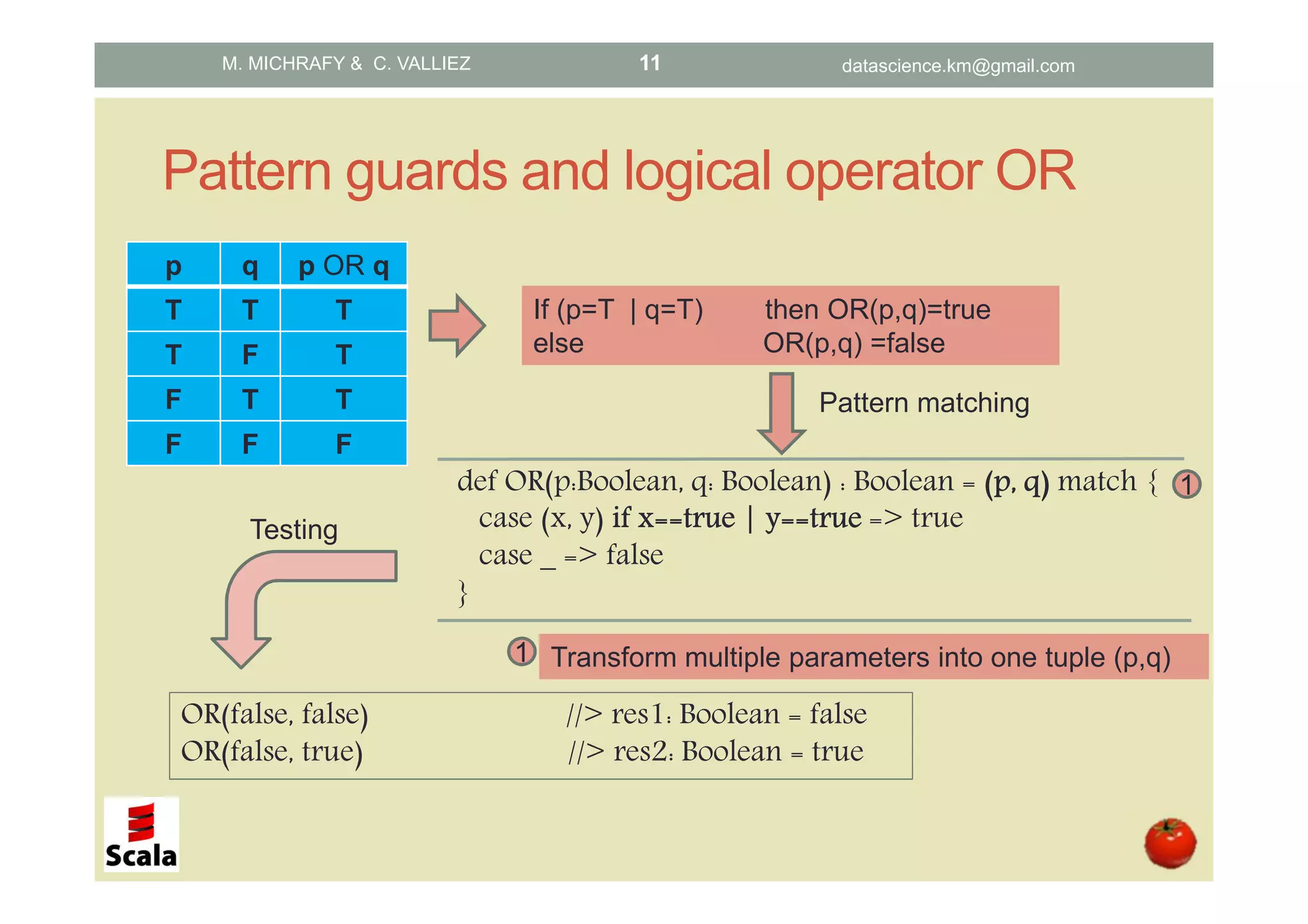
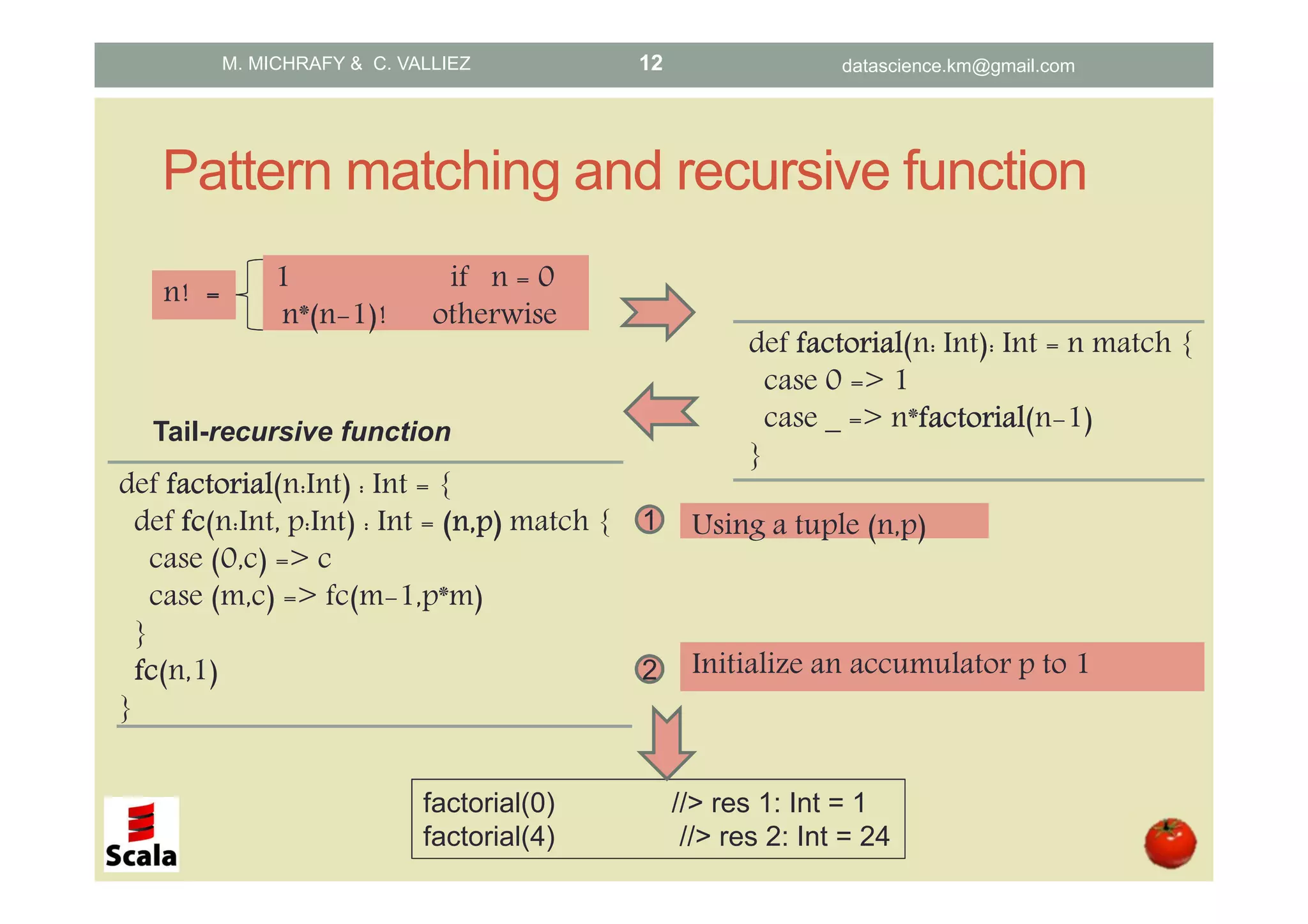
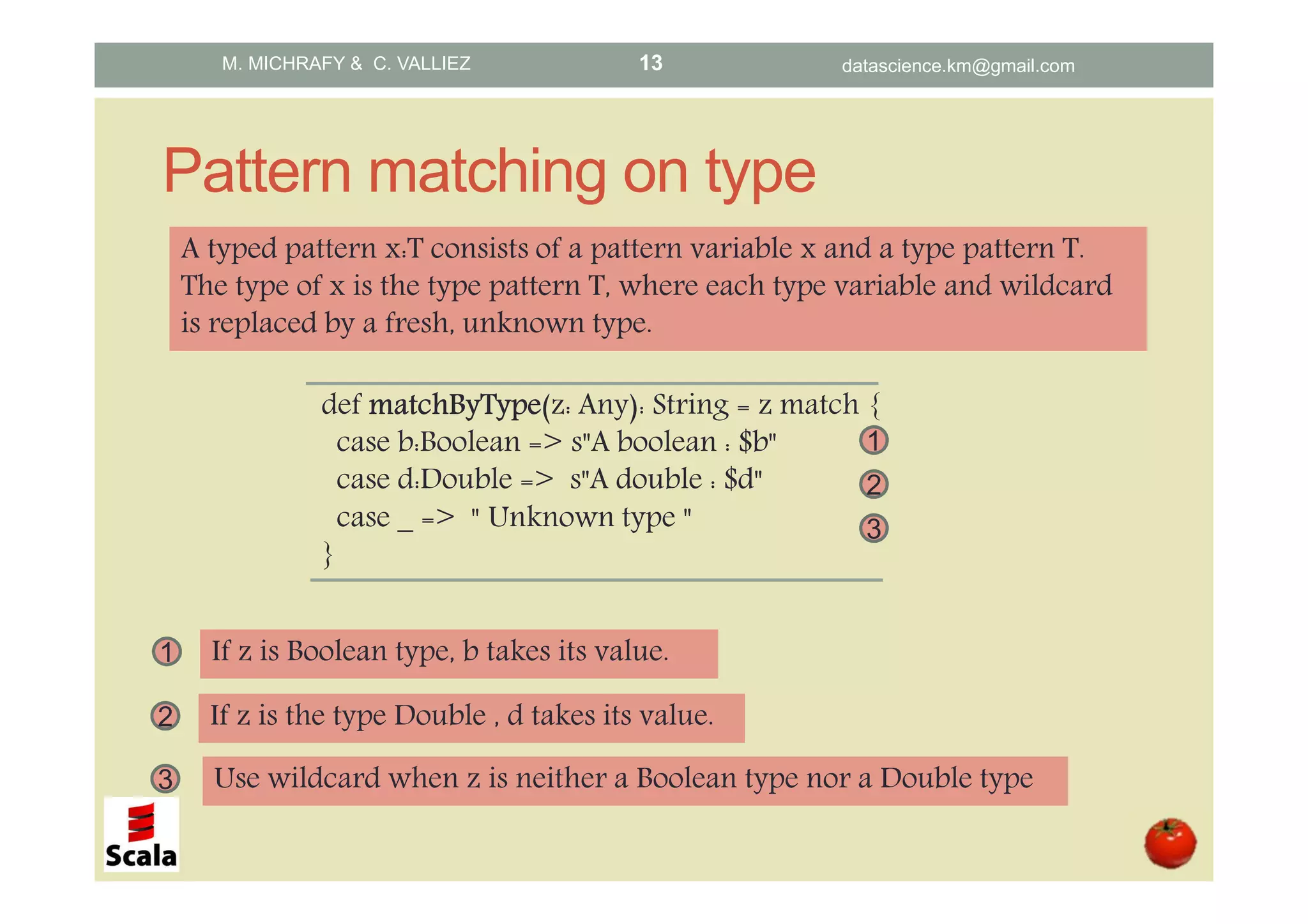
![Pattern matching on tuple def detectZeroInTupledetectZeroInTupledetectZeroInTupledetectZeroInTuple(x: Tuple2[Any,Any]):String = x match { case (0,0|(0,0)) => "Both values zero." case (0,b) => s"First value is 0 in (0,$b)" case (a, 0) => s"Second value is 0 in ($a, 0)" case _ => "Both nonzero : " + x } 1 The tuple pattern matches input in tuple form and enables the tuple to be decomposed into its constituent elements by using pattern matching variables for each position in the tuple. detectZeroInTuple((0,(0,0))) //> res1: String = Both values zero. detectZeroInTuple((0,0)) //> res2: String = Both values zero. detectZeroInTuple((0,11)) //> res3: String = First value is 0 in (0,11) 1 Match a first pattern if x=(0,0) or x=(0,(0,0)). M. MICHRAFY & C. VALLIEZ datascience.km@gmail.com14](https://image.slidesharecdn.com/scalapatternmatching-160328221627/75/Scala-Pattern-matching-Concepts-and-Implementations-14-2048.jpg)
 : String = x match{ case Some(x) => s"Some $x" case None => "None " } 1 Option -sealed abstract class- represents optional values. Instances of Option are either an instance of SomeSomeSomeSome or the object None.None.None.None. getValueOption(Option("hello")) //> Some hello getValueOption(Option(null)) //> None getValueOption(Option(())) //> Some () getValueOption(Option(List(10,11))) //Some List(10, 11)) 1 Match a Some(x) if x represents an existing value. Option Some None c c o 2 Match a None if x represents a non-existing value. 2 M. MICHRAFY & C. VALLIEZ datascience.km@gmail.com15](https://image.slidesharecdn.com/scalapatternmatching-160328221627/75/Scala-Pattern-matching-Concepts-and-Implementations-15-2048.jpg)
![Pattern matching on immutable collection import scala.collection.immutable._ def getTypegetTypegetTypegetType(x:Traversable[Any]) : String = x match{ case s:Set[Any] => s"A Immutable Set : $s" case q:Seq[Any] => s"A Immutable Seq : $q" case _ => "A Immutable Map : $x" } getType(Set(0,2,4)) //> A Immutable Set : Set(0, 2, 4) getType(1 to 3) //> Immutable Seq : Range(1, 2, 3) getType(HashMap[Int,Int](1->13)) //> A Immutable Map : Map(1 -> 13) 2 Match a pattern then the type of x is returned Iterable Set Map Seq t t t t traversable t 1 1 2 3 3 Match wildcard then type map is returned This hierarchy is valid for mutable and immutable collections M. MICHRAFY & C. VALLIEZ datascience.km@gmail.com16](https://image.slidesharecdn.com/scalapatternmatching-160328221627/75/Scala-Pattern-matching-Concepts-and-Implementations-16-2048.jpg)
![Pattern matching on Immutable Map import scala.collection.immutable._ def getTypeOfMapgetTypeOfMapgetTypeOfMapgetTypeOfMap(x:Map[Int,Int]) : String = x match{ case _:HashMap[Int,Int] => "A HashMap " case _:TreeMap[Int,Int] => "A TreeMap " case _ => "A ListMap " } getTypeOfMap(HashMap[Int,Int](1->12,2->10)) //>A HashMap getTypeOfMap(TreeMap[Int,Int](1->3,6->6)) //> A TreeMap getTypeOfMap(ListMap[Int,Int](1->13,6->16)) //> A ListMap 1 if x is neither a HashMap nor a TreeMap then x is a ListMap Map HashMap ListMap TreeMap t c c c This hierarchy is valid only for the immutable Map Map is a Trait and all (children) are implementation classes 1 M. MICHRAFY & C. VALLIEZ datascience.km@gmail.com17](https://image.slidesharecdn.com/scalapatternmatching-160328221627/75/Scala-Pattern-matching-Concepts-and-Implementations-17-2048.jpg)
![Pattern matching on immutable Set import scala.collection.immutable._ import scala.collection.immutable.BitSet._ def getTypeOfSetgetTypeOfSetgetTypeOfSetgetTypeOfSet(x:Set[Int]) : String = x match{ case h:HashSet[Int] => "A HashSet " + (h.size,h.sum) case t:TreeSet[Int] => "A TreeSet " + (t.size,t.sum) case l:ListSet[Int] => "A ListSet " + (l.size,l.sum) case z:AnyRef => "type : " + z.getClass.getName } getTypeOfSet(new BitSet1(10)) //> type : scala.collection.immutable.BitSet$BitSet1 getTypeOfSet(HashSet(1,10,12)) //> A HashSet (3,23) getTypeOfSet(TreeSet(1,10)) //> A TreeSet (2,11) getTypeOfSet(ListSet(1,11,12)) //> A ListSet (3,24) Set HashSet ListSet BitSet t c c c This hierarchy is valid only for the immutable Set. The Set is a Trait. BitSet is an abstract class and all children are the class. TreeSet c SortedSet t The subclasses of the abstract class BitSet are BitSet1, BitSet2 and BitSetN M. MICHRAFY & C. VALLIEZ datascience.km@gmail.com18](https://image.slidesharecdn.com/scalapatternmatching-160328221627/75/Scala-Pattern-matching-Concepts-and-Implementations-18-2048.jpg)
 : Int = ls match{ case Nil => 0 case _::q => sizeList(q) + 1 } The following function computes the length of a list. It is based on two constructors NilNilNilNil and “::”. sizeList(List()) //> res40: Int = 0 sizeList(List(1)) //> res41: Int = 1 sizeList(List(1,(1,2),3,4)) //> res42: Int = 4 1 If the list is empty, Nil, then we return 0. 2 If ls represents a no-empty list then the length of list is (1+length(q)), where q represents the tail of the list. 1 2 M. MICHRAFY & C. VALLIEZ datascience.km@gmail.com19](https://image.slidesharecdn.com/scalapatternmatching-160328221627/75/Scala-Pattern-matching-Concepts-and-Implementations-19-2048.jpg)
![Pattern matching on List 2/2 def identifyListeidentifyListeidentifyListeidentifyListe(ls: List[Any]): String = ls match { case Nil => "empty list" case _::Nil => "list with single element" case _::_::Nil => "list has two elements" case _ => "list has at least tree elements" } All lists are built from two constructors : NilNilNilNil and “::”.... NilNilNilNil represents a empty list :::::::: builds a non empty list characterized by a head and a tail. identifyListe(Nil) //> empty list identifyListe(List((1,2))) //> list with single element identifyListe(List("Scala", 3)) //> list has two elements identifyListe(List(1,2,3)) //> list has at least tree elements M. MICHRAFY & C. VALLIEZ datascience.km@gmail.com20](https://image.slidesharecdn.com/scalapatternmatching-160328221627/75/Scala-Pattern-matching-Concepts-and-Implementations-20-2048.jpg)
![Pattern matching on case class case class PersonPersonPersonPerson(name: String, age: Int) def validateAgevalidateAgevalidateAgevalidateAge(p: Person): Option[String] = p match { case Person(name, age) if age > 18 => Some(s"Hi $name! age $age") case _ => None } Case classes are classes that get to String, hashCode, and equals methods automatically. It provide a recursive decomposition mechanism via pattern matching validateAge(Person("Alice", 19)) //> Some(Hi Alice! age 19) validateAge(Person("Bill", 15)) //> None 2 If the age is greater than18 , then we return the name and age of the person. 3 If the age of the person is less than 18 , then we return None. 2 3 1 1 We define a case class of a person with name and age. M. MICHRAFY & C. VALLIEZ datascience.km@gmail.com21](https://image.slidesharecdn.com/scalapatternmatching-160328221627/75/Scala-Pattern-matching-Concepts-and-Implementations-21-2048.jpg)
![Nested Pattern Matching in Case Classes case class Address(street: String, city: String, country: String) case class Person(name: String, age: Int, address:Address) def checkPrscheckPrscheckPrscheckPrs(p: Person): Option[String] = p match { case Person(name, age, null) if age > 18 => Some(s"Hi $name! age $age") case Person(name, age, Address(_,_,ctr)) => Some(s"Hi $name! age $age $ctr") case _ => None } checkPrs(Person("Alice", 19,null)) //> Some(Hi Alice! age 19) checkPrs(Person("Bill", 15, Address("Scala Lane", "Chicago", "USA"))) //> Some(Hi Bill! age 15 USA) 2 If age > 18 & address = null, then we return the name and age of the person. 3 If the address != null then we return the name, age and the city of the person. 3 2 1 We define two case classes Address and Person. Person contains a subclass Address. 1 Case classes can contain other case classes, and the pattern matching can be nested. M. MICHRAFY & C. VALLIEZ datascience.km@gmail.com22](https://image.slidesharecdn.com/scalapatternmatching-160328221627/75/Scala-Pattern-matching-Concepts-and-Implementations-22-2048.jpg)
![Matching on regular expression val email = """(.*)@(.*).(.*)""".r val date = """(dddd)-(dd)-(dd)""".r def checkPattern(x:String) : Option[String] = x match{ case email(name,domain,extension) => Some(s"$name $domain $extension") case date(year, month, day) => Some(s"$year $month $day") case _ => None } A regular expression is used to determine whether a string matches a pattern and, if it does, to extract or transform the parts that match. Scala supports regular expressions through Regex class available in the scala.util.matching package. 2 3 1 4 1 We define a regular expressions for email and date by using the method rmethod rmethod rmethod r2 3 If regex of email is matched then extract name, domain and extension 4 If regex of date is matched then extract year, month and day checkPattern("info@scala.fr") //> Some(info scala fr) checkPattern("2016-03-26") //> Some(2016 03 26) M. MICHRAFY & C. VALLIEZ datascience.km@gmail.com23](https://image.slidesharecdn.com/scalapatternmatching-160328221627/75/Scala-Pattern-matching-Concepts-and-Implementations-23-2048.jpg)
